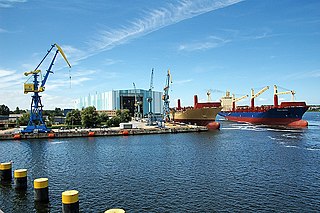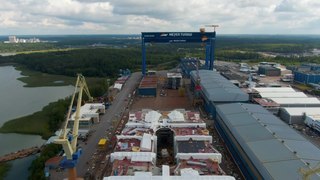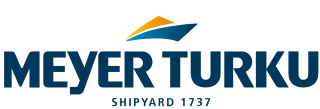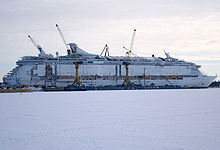
Viking Line Abp is a Finnish shipping company that operates a fleet of ferries and cruiseferries between Finland, the Åland Islands, Sweden and Estonia. Viking Line shares are quoted on the Helsinki Stock Exchange. Viking Line is operated from Åland.

Meyer Werft is a German shipyard headquartered in Papenburg at the river Ems. Founded in 1795 and starting with small wooden vessels, today Meyer Werft is a builder of luxury passenger ships. 700 ships of different types have been built at the yard. Its "Dockhalle 2" is the third largest shipbuilding hall and the building with the fifth-largest usable volume in the world as of 2022.

Celestyal Crystal is a cruise ship, operated between 2007 and 2023 by the Cyprus-based Louis Group's Louis Cruise Lines and Celestyal Cruises. The ship was originally built as the cruiseferry Viking Saga in the 1980 at Wärtsilä Perno Shipyard and Turku Shipyard, Turku, Finland for Rederi Ab Sally. In 1986 she was renamed Sally Albatross, and rebuilt into a cruise ship the following year. The ship was destroyed by a fire in 1990, and completely rebuilt at Finnyards, Rauma, Finland. She was re-delivered in 1992, still named Sally Albatross. After partially sinking 1994 she was rebuilt at Industrie Navali Meccaniche Affini, La Spezia, Italy, re-entering service as Leeward for Norwegian Cruise Line. Subsequently she sailed as SuperStar Taurus for Star Cruises, Silja Opera for Silja Line. After being temporarily renamed Opera she was in service with Louis Group as Louis Cristal and later Celestyal Crystal.

MS Star Pisces was a cruise ship owned by Star Cruises and did short cruises from Hong Kong. She was originally built as the cruiseferry MS Kalypso in 1990 at Masa-Yards Turku New Shipyard, Finland for Rederi AB Slite for use in Viking Line traffic. The ship was designed by Per Dockson. Star Pisces had a sister ship, Pearl Seaways.

The Finnish maritime cluster is a cluster of Finnish companies in maritime industries. In 2016 the total turnover was estimated at 13 billion euros and it employed 48,000 people.
STX Europe AS, formerly Aker Yards ASA, was until 2012 a subsidiary of the South Korean STX Offshore & Shipbuilding.

Crichton-Vulcan is an abandoned shipyard in Turku, Finland, that once formed the cornerstone of the Finnish shipbuilding industry. The shipyard is best known for the World War II coastal defence ships and submarines it produced.
Name Turku shipyard usually means either of the following yards in Turku, Finland:
Wärtsilä Marine was a Finnish shipbuilding company.

Hietalahti shipyard is a shipyard in Hietalahti, in downtown Helsinki, Finland. Since 2019, it has been operated by a company named Helsinki Shipyard.
Aker Arctic Technology Oy is a Finnish engineering company that operates an ice model test basin in Helsinki. In addition to ship model testing, the company offers various design, engineering and consulting services related to icebreakers, other icegoing vessels and arctic offshore projects as well as full scale trials, field expeditions and training for icy conditions. Formerly the arctic research centre of Wärtsilä and later Masa-Yards, Aker Arctic was established on 30 December 2004 as an independent company with Finnish Industry Investment Ltd, ABB and Aker Solutions as its current shareholders.
TUI Cruises is a cruise line based in Germany. It was formed in 2007 as a joint venture between the German tourism company TUI AG and the American cruise line operator Royal Caribbean Group, both of whom hold a 50% stake in the company.

An oblique icebreaker is a special type of icebreaker designed to operate not only ahead and astern, but also obliquely (sideways) with a large angle of attack. In this way, a relatively small icebreaker is capable of opening a wide channel in ice for large merchant ships.
Helsinki shipyard may refer to the following shipyards, which have operated in Helsinki.

Meyer Wismar is a German shipbuilding company, headquartered in Wismar. After June 1, 1990 it was part of the Deutschen Maschinen- und Schiffbau AG, from 2009 it was part of the Nordic Yards Holding GmbH, and in 2016 it became part of the Lloyd Werft Group. In June 2022 Thyssenkrupp Marine Systems (TKMS) acquired the Wismar site of MV Werften. In November 2022, a lease agreement was signed with Meyer Werft to complete the Global Dream with the yard renamed Meyer Wismar.

Mein Schiff 3 is a cruise ship owned by TUI Cruises, and the first custom new build for the cruise line. She was delivered from STX Finland Turku Shipyard on 22 May 2014 and was followed by identical sister ships, Mein Schiff 4 in 2015, Mein Schiff 5 in 2016, Mein Schiff 6 in 2017. In addition, Mein Schiff 1 and Mein Schiff 2 were confirmed on 1 July 2015, with deliveries set for 2018 and 2019.
Rauma shipyard is a shipyard in Rauma, Finland. It was previously operated by STX Finland which is owned by the South Korean STX Corporation. Rauma shipyard is specialized in large ferries, small cruise ships, multipurpose icebreakers and small naval craft.

Perno shipyard is a shipyard in Turku, southwest Finland, that specialises in building cruise ships, passenger ferries, special vessels and offshore projects. The yard area is 144 hectares and is operated by Meyer Turku Oy with a dry dock 365 metres (1,198 ft) long, 80 metres (260 ft) wide and 10 metres (33 ft) deep. It has the largest bridge crane in the Nordic region with a capacity of 1,200 tonnes and a smaller crane with a capacity of 600 tonnes.

Meyer Turku Oy is a Finnish shipbuilding company located in Turku, Finland Proper. The company is fully owned by German shipbuilder Meyer Werft GmbH. The main products are cruise ships and cruiseferries.
Oy Laivateollisuus Ab (LaTe) was a Finnish shipbuilding company located in Pansio, Turku. The company was founded in 1945 to serve Finnish war reparation industry and focused on wooden ships. The first vessels were a series of schooners, which were followed by other wooden vessels. The last wooden hulls were produced in 1958. The company continued producing wooden gluelam structures in parallel with shipbuilding.













